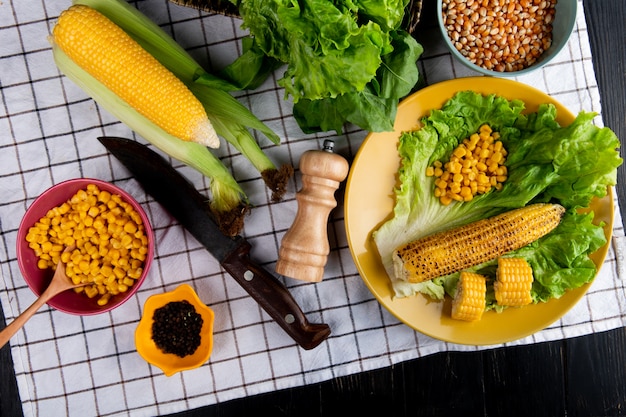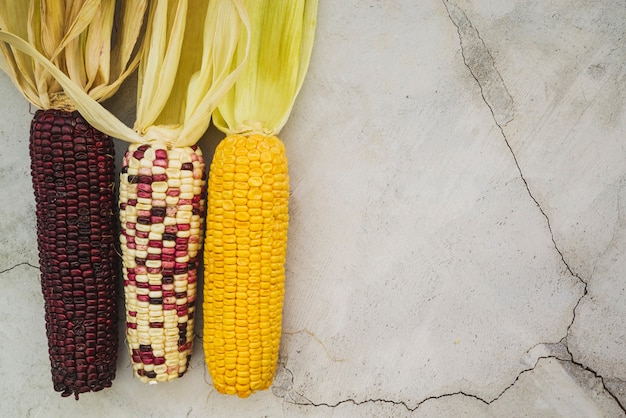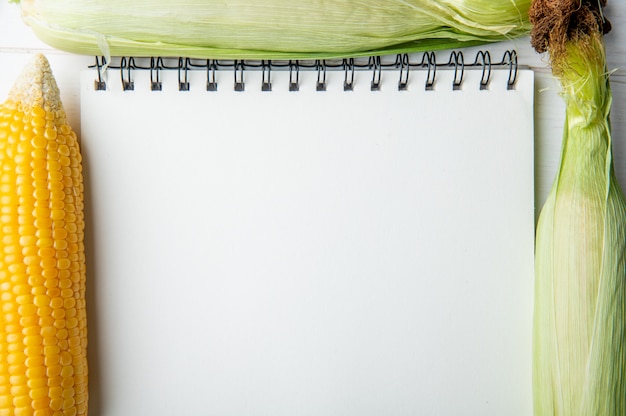Ah, the sweet, juicy kernels of fresh corn on the cob – a taste of summer that instantly transports me back to childhood picnics and lazy afternoons on the porch. For years, I've been perfecting my corn-cooking skills, trying out different methods and experimenting with flavour combinations. Today, I want to share my secrets with you, so you can create the most delicious corn on the cob, every single time.
This isn't just a guide to the mechanics of cooking corn, it's a celebration of its seasonal bounty. We'll dive into the best ways to select the perfect corn, explore various cooking methods to suit your taste and time constraints, and delve into a world of flavourful seasonings. Get ready to become a corn-cooking maestro!
Part 1: Choosing the Right Corn

From the Market to Your Kitchen
The journey to mouthwatering corn on the cob begins with selecting the very best cobs. I always head to the local farmers' market, where the corn is bursting with freshness and flavour, often picked just hours before. Look for cobs with vibrant green husks, tightly packed kernels, and no signs of browning or wilting.
How to Tell if Corn is Ripe
There are a few tried-and-true methods to ensure you're getting the sweetest, juiciest corn:
- The Silk Test: Gently pull back a bit of the husk and examine the silk. If it's dry and brown, the corn may be past its prime. You want fresh, vibrant yellow silk – a sign of sweet kernels waiting to be enjoyed.
- The Feel Test: Gently press on the kernels with your thumb. Ripe corn should feel firm and springy, like a well-filled bouncy ball. Avoid any cobs that feel soft or mushy.
- The Peel Test: If you're still unsure, peel back a small section of the husk. The kernels should be plump and pearly white, almost glowing with freshness. If they appear shrunken or discoloured, move on to another cob.
Part 2: Preparing the Corn

Cleaning and Husking
Once you've chosen your perfect cobs, it's time to give them a quick clean-up. I usually start by rinsing them under cold water, gently removing any loose husks or stray silks. Then, I pull back the husk, leaving a few inches at the bottom to act as a handle. This way, you can easily grab the cob without burning your fingers during cooking.
Removing the Silk
Ah, the dreaded silk. It's a bit of a nuisance, but I find it easiest to remove it after cooking. The steam softens the silk, making it a breeze to pull off. If you're feeling impatient, you can remove it before cooking, just be careful not to remove too much of the husk, as it acts like a natural wrapper, protecting the kernels from drying out. A little patience will go a long way in ensuring a perfectly cooked corn on the cob.
Part 3: Cooking Methods

Now, we're getting to the heart of it - the cooking! I've tried countless methods, and each one delivers a unique flavour and texture. Here are a few of my personal favourites:
Boiling
Boiling is the simplest and most reliable way to cook corn. Fill a large pot with water, bring it to a rolling boil, then gently add your corn cobs. Reduce the heat to a simmer and cook for 5-7 minutes, or until the kernels are tender and slightly translucent. Boiling is perfect for busy weeknights when you want a quick and delicious side dish.
Grilling
For that irresistible smoky flavour, grilling is the way to go. Remove the husks, leaving the silks intact. They'll act as a natural wrapper, infusing the corn with a subtle smokiness. Place the cobs directly on the grill, over medium heat, and cook for 10-15 minutes, turning occasionally. Keep an eye out for those beautiful char marks – a sign of perfect grilling.
Microwave
Short on time? The microwave comes to the rescue. Remove the husk and silk, then wrap the corn cob in a damp paper towel. This will help to steam the corn and prevent it from drying out. Microwave on high for 2-3 minutes, or until the kernels are heated through. It's a quick and easy option when you need a delicious snack or side dish in a hurry.
Steam Cooking
For a gentle cooking method that preserves the corn's natural sweetness, steam is the way to go. Place the corn cobs in a steamer basket, over a pot of boiling water. Cover and steam for 5-8 minutes, or until the kernels are tender. Steam cooking is a great way to ensure that the corn stays bright and vibrant, preserving its natural flavours.
Part 4: The Art of Seasoning
Now, we're getting into the fun part – the seasoning. This is where you can really unleash your creativity and elevate your corn on the cob from simple to sublime. Here are a few of my go-to flavour combinations, but feel free to experiment and find your own favourites:
Classic Butter and Salt
This is a classic for a reason. The simplicity of butter and salt allows the corn's natural sweetness to shine through. Melt some butter in a small bowl, then brush it generously over the cooked corn. Season with salt to taste. It's a timeless combination that's always satisfying.
Herbed Butter
For a touch of freshness and aromatic complexity, try adding herbs to your butter. My favourite combination is parsley, chives, and garlic. Simply chop the herbs, mix them into softened butter, and spread it over the corn. The fresh herbs complement the sweet corn beautifully.
Spicy Seasoning
If you like a little heat, spice up your corn with a sprinkle of chili powder or cayenne pepper. Add a pinch of cumin for an earthy, smoky kick. This is perfect for those who appreciate a little kick with their sweet corn.
Creamy Cheese Sauce
For a decadent treat, try a creamy cheese sauce. Mix together softened cream cheese, sour cream, and grated cheese. Drizzle it over the cooked corn and sprinkle with chives or parsley. It's a luxurious and satisfying twist on classic corn on the cob.
Part 5: Serving Corn on the Cob
A Feast for the Senses
Corn on the cob is incredibly versatile. It's perfect for picnics, barbecues, or a simple weeknight dinner. It can be served hot or cold and pairs beautifully with a variety of side dishes, like potato salad, baked beans, or grilled vegetables.
Presentation Matters
I like to present my corn on the cob on a platter or in a basket, adorned with fresh herbs and lemon wedges. It's all about creating a visually appealing and inviting presentation. A splash of colour and a touch of greenery instantly elevate the dish.
Part 6: Storing and Reheating
Storing Leftovers
If you have leftover cooked corn, you can store it in the refrigerator for up to 3 days. Wrap the corn in plastic wrap or place it in an airtight container.
Reheating Tips
To reheat cooked corn, you can microwave it for a few minutes, wrap it in foil and bake in a preheated oven, or grill it until heated through. I find that the grill gives the corn a nice char and flavour, bringing back that smoky goodness.
Part 7: corn on the cob variations
Beyond the Basics
Once you've mastered the basics, you can start experimenting with different variations of corn on the cob. Here are a few ideas to get your creative juices flowing:
- Corn Fritters: Combine cooked corn kernels with flour, eggs, and spices. Form the mixture into small patties and fry until golden brown. Serve them with a dollop of sour cream or a drizzle of honey.
- corn salad: Cut the kernels off the cob and toss them with fresh vegetables, herbs, and a light vinaigrette. Add some crumbled feta cheese or toasted nuts for extra flavour and texture.
- Corn Chowder: Blend cooked corn kernels with potatoes, onions, and milk for a creamy and comforting soup. Top it with crispy bacon, chopped chives, or a swirl of cream.
- grilled corn Salsa: Combine grilled corn kernels with diced tomatoes, onions, cilantro, and a spicy lime dressing for a vibrant and refreshing salsa. Serve it with tortilla chips or as a topping for tacos.
Part 8: FAQs
Common Questions and Answers
Here are some frequently asked questions about cooking fresh corn on the cob:
| Question | Answer |
|---|---|
| What's the best way to cook corn on the cob for maximum flavour? | Grilling is the best way to cook corn for that smoky, irresistible flavour. If you don't have a grill, boiling works well too, especially for a quick and easy weeknight meal. |
| How do I know if my corn is cooked? | The kernels should be tender and slightly translucent when cooked. You can also test it by piercing a kernel with a fork - it should slide easily off the cob. |
| How long can I store corn on the cob in the refrigerator? | Cooked corn on the cob can be stored in the refrigerator for up to 3 days, so you can enjoy its deliciousness for a few days after cooking. |
| What are some creative ways to serve corn on the cob? | You can serve it hot or cold, as a side dish, or even use it as an ingredient in other dishes like corn fritters, salad, or chowder. Get creative and experiment with different flavour combinations. |
| What should I do if my corn is overcooked? | Don't despair! Overcooked corn can still be used in dishes like corn chowder or cornbread. Just avoid serving it on its own. |
| Can I freeze corn on the cob? | Yes, you can freeze corn on the cob. Simply blanch the cobs for a few minutes, then cool them completely before wrapping them in plastic wrap and placing them in a freezer bag. frozen corn can be stored for up to 12 months. |
Part 9: Conclusion
cooking corn on the cob is a simple yet rewarding culinary experience. From selecting the perfect cobs to mastering different cooking methods and flavour combinations, there's a world of possibilities to explore. I hope this guide has inspired you to embrace the joy of fresh corn and create your own delicious masterpieces. So, next time you're at the market, grab a handful of those vibrant green cobs, and get cooking! Happy corn season!
Everyone is watching

How to Cook Frozen Lobster Tails Perfectly: A Step-by-Step Guide
RecipesLobster. Just the word conjures up images of lavish meals, special occasions, and a taste of luxury. But let's...

Pigs in a Blanket Cooking Time: How Long to Bake for Perfect Results
RecipesAh, pigs in a blanket. Just the name conjures up images of those delightful little parcels of crispy pastry en...

Pork Fillet Cooking Time: How Long to Cook It Perfectly
RecipesPork fillet, or tenderloin as it's sometimes called, is a real favourite in our house. It's so versatile, and...

The Ultimate Guide to Cooking Sweet Potatoes: From Roasting to Mashing
RecipesSweet potatoes. Just the name conjures up images of warm, comforting dishes, bursts of vibrant color, and a to...

The Ultimate Guide to Tender, Juicy Pulled Pork
RecipesRight, let's talk pulled pork. It's one of those dishes that just screams "comfort food," doesn't it? I mean...
